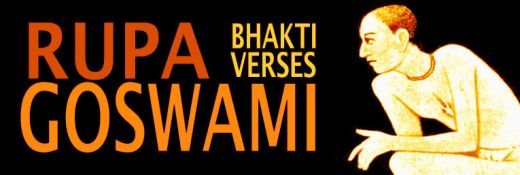suddha-sattva-viseshatma
prema-suryamsu-samya-bhak
rucibhis citta-masrinya-
krid asau bhava ucyate
“‘When bhakti is executed on the transcendental platform of pure goodness (suddha-sattva), it is like a sun-ray of love for Krishna. At such a time, bhakti causes the heart to be softened by various tastes, and one is then situated in bhava (ecstatic emotion).” Bhakti-rasamrita-sindhu (1.3.1)
kshantir avyartha-kalatvam
viraktir mana-sunyata
asa-bandhah samutkantha
nama-gane sada rucih
asaktis tad-gunakhyane
pritis tad-vasati-sthale
ity-adayo ‘nubhavah syur
jata-bhavankure jane
“When the seed of ecstatic emotion for Krishna fructifies, the following nine symptoms manifest in one’s behavior: forbearance, concern that time should not be wasted, detachment, absence of false prestige, hope, eagerness, a taste for chanting the holy name of the Lord, attachment to descriptions of the transcendental qualities of the Lord, and affection for those places where the Lord resides — that is, a temple or a holy place like Vrindavana. These are all called anubhava (subordinate signs of ecstatic emotion). They are visible in a person in whose heart the seed of love of God has begun to fructify.” Bhakti-rasamrita-sindhu (1.3.25-26)
Rupa Goswami’s Bhakti-rasamrita-sindhu is one of the foundational texts in the Chaitanya-vaishnava lineage of bhakti-yoga. It is an assimilation of the teachings that Rupa Goswami received from Sri Chaitanya in a ten day discussion held on the bank of the Ganga at Dasasvamedha-ghata in Pryaga. Bhakti-rasamrita-sindhu elaborates on the nature, practices and gradations of bhakti as well as the components of bhakti-rasa (the experience of pure devotion).
The above verses discuss bhava (devotional ecstacy), the eighth of nine stages of advancement in bhakti, culminating in prema (pure love of God). Bhava is seen as the preliminary, budding stage or sprout of prema. Verse 1.3.1 reveals both the primary and secondary characteristics of bhava. The primary characteristic is suddha-sattva-viseshatma, one’s heart, or one could say one’s consciousness, becomes influenced by the touch of suddha-sattva (pure goodness), which is the direct influence of the Lord’s potency. This implies that one is no longer held under the sway of the gunas (sattva, rajas, and tamas). The secondary characteristic of bhava is the softening of the heart which gives rise to various devotional tastes or experiences. One who is situated on the stage of bhava will be easily moved by devotional stimulus such as kirtan, hearing the recitation of devotional texts, ect.
Verses 1.3.25-26 reveal nine symptoms which can been seen in the character of one who has achieved the stage of bhava. These symptoms are seen as excellent criterion for determining advancement in bhakti, as opposed to other types of displays which may be easily imitated.
Kshanti: perseverance. Remaining tolerant and patient, even amid disturbance.
Avyartha-kalatvam: utilization of time. Refers to constant engagement in devotional seva (service).
Virakti: detachment. Completely indifference to the objects of sense gratification.
Mana-shunyata: absence of false prestige or pridelessness. To feel humble, free from the longing for being shown respect.
Asha-bandha: hope. To be always certain that Krishna will bestow His mercy on oneself.
Samutkanta: An intense eagerness to achieve or ardent desire for attaining one’s desired supreme object (prema).
Nama-gane sada ruci: Thirst arising out of affection for constantly chanting the Lord’s holy names.
Asaktis tad-gunakhyane: A natural attachment to describe the Lord’s most sweet qualities, pastimes and so on.
Pritis tad-vasati-sthale: The desire to reside in the places of the Lord’s pastimes such as Vrindavana.
Kaustubha das
Rupa Goswami (1489-1564 CE) is a teacher, poet, and philosopher from the Gaudiya Vaishnava tradition of Bhakti-yoga. Along with his brother Sanatana Goswami he was considered the leader of the Six Goswamis of Vrindavan – a highly influential group of acetic disciples of the Vaishnava saint/avatar, Sri Chaitanya. Rupa Goswami wrote a number of important books in Sanskrit on bhakti philosophy, poetics, drama and dramaturgy. He is also credited with uncovering various holy places associated with the life of Krishna in Vrindavan.

Comments
One response to “Nine Symptoms of Advanced Bhakti”
Oh, I like this one! Thank you, Kaustubha. When I conducted a Nectar of Devotion/Bhaktirasamrita-sindhu study group on the Big Island for a couple of years, I noted that the symptom of bhava Srila Prabhupada mentioned most often was avyartha-kalatvam.
More, please.